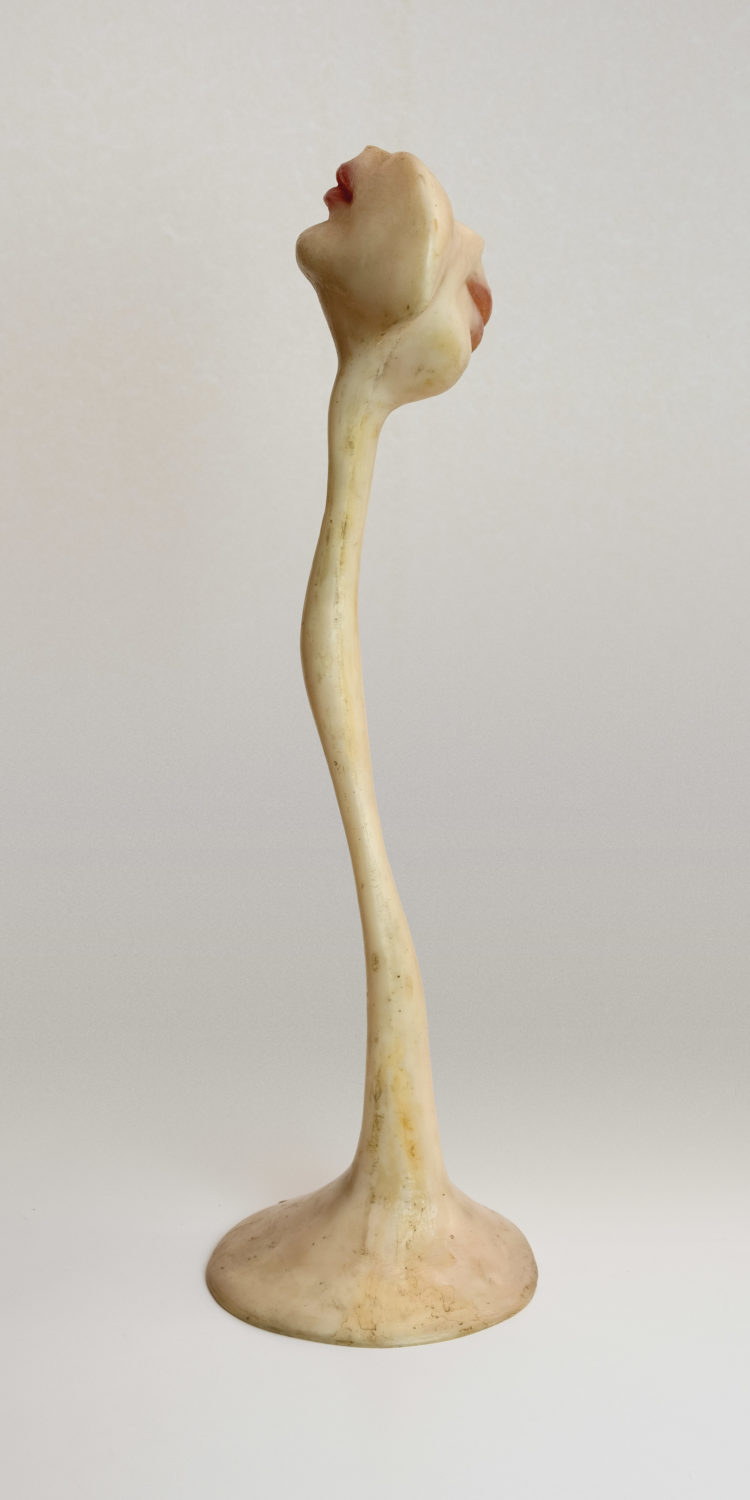“My gesture is directed towards the human body, this «completely erogenous sphere» (…) through the imprints of the human body, I try to capture in transparent polystyrene the fleeting moments of life, its paradoxes and its absurdity (…) the human body is the most sensitive, only source of all joy, all pain and all truth.“
Alina Szapocznikow
Alina Szapocznikow – one of the most important post-war Polish artists and the most original sculptors of the 20th century, born on May 16, 1926 in Kalisz. She came from a family of Jewish doctors. During the war, she was in the ghetto in Pabianice, and then she was imprisoned in the German concentration camps: Auschwitz-Birkenau, Bergen-Belsen and Theresienstadt. After liberation, despite the fact that her mother returned to Łódź, Szapocznikow decided to live in Prague. There she started an artistic apprenticeship in the studio of the sculptor Otokar Velimski, and then began studies at the Higher School of Art and Industry under professor Josef Wagner. Thanks to the Szapocznikow scholarship, she studied at the École Nationale Supérieure des Beaux-Arts in Paris for four years. As a freelance student, she studied at Paul Niclausse‘s studio. However, a severe illness forced her to quit her studies. In 1951, the artist returned to Poland and settled permanently in Warsaw, where she owned a studio. Initially, she made sculptures in the contemporary socialist realist style, mainly monument projects and realizations. After The Thaw in the mid-1950s, she was finally able to show what fascinated her: form and material. At that time, she created realistic and close to abstract images of young women and dramatic sculptures referring to war experiences. In the 1960s, she began making assemblages – sculptures combined from various structures and materials. In 1962 she participated in the Venice Biennale.
In 1963, she left the country and settled permanently in Paris. In the studio in Malakoff, she experimented with new materials: polyester and polyurethane. She mainly created spatial compositions using casts of her own body and those of her relatives (Multiplied Portraits). In 1965, she won a Copley Foundation Award for an assemblage entitled Goldfinger. The award was granted by a jury composed of Murcel Duchamp, Jean Arp, and Max Ernst.
At the end of her life, some of her projects were both conceptual and personal in character. She created a series of distorted self-portraits (Nowotwory [Tumors] and Nowotwory uosobione [Tumors Personified]) and in the last year of her life she made Zielnik [Herbarium] – a kind of album with flattened, unreal body casts of her and her son Piotr. She died on March 2, 1973 in the Praz-Coutant sanatorium in Passy, after a long struggle with cancer.
She developed an individual language with which she dealt with both the trauma of the Holocaust and the disintegration of her own body. She was one of the brilliant European pioneers of women‘s art.
In 2012, the Museum of Modern Art in New York hosted an individual exhibition of over 100 drawings and sculptures by Alina Szapocznikow. The curators of the exhibition “Alina Szapocznikow – Sculpture Undone 1955-1972“ were Elena Filipovic and Joanna Mytkowska.

Alina Szapocznikow “Bouches en Marche” (Marching Lips), 1966, polyester resin, 53 cm height
At the “Multiplied Portrait” exhibition, we present for the first time a film documenting the RETROSPECTIVE EXHIBITION of Alina Szapocznikow, curated by Anda Rottenberg. This exhibition took place at Zachęta – National Gallery of Art in Warsaw in 1998. The film shown in the Gallery was prepared especially for the exhibition in Kalisz by Róża Fabiańska and Sławomir Malcharek. We also show reproductions of the polyester sculpture “Marching Lips“ from 1966 and monotypes from 1960 – 1961. All are from private collections of, among others, Krzysztof M Bednarski and prof. Waldemar Baraniewski. One can also watch two films promoting Alina Szapocznikow and her works. The first is a document made by Dr. Mor Presiado presenting the artist‘s figure, which we present in the original Hebrew language version. It is part of the Massive Open Online Course (MOOC) project: “Fixing the World: Feminist Art and Jewish Identity,“ which tells the story of Jewish artists, their struggle for equality and justice in the art world and beyond. The second is “Beautiful Polin“ from 2018. The film was made under the supervision of Mrs. Izabela Galuba-Brya and its authors are: Ola Gadzinowska, Ewelina Wojtynka, Hubert Pietrasiak, and Dorota Kowalska. This document won an award in a competition organized by the international foundation “Centropa,“ which deals with education and memory of the Holocaust. The “Multiplied Portrait“ presentation is complemented by catalogs from Alina Szapocznikow‘s exhibitions, e.g. at the MOMA Museum in New York, at the Zachęta – National Gallery of Art in Warsaw, at IRSA Fine Art “HOTEL DE SAKE” in Warsaw and at the Silesian Museum in Katowice.
Dr. Mor Presiado:
“Beautiful Polin“:
Presented at the Art Gallery and Jan Tarasin in Kalisz, the exhibition “Multiplied Portrait“ by Alina Szapocznikow is part of the special events that accompany the 82nd anniversary of the first deportations of Jews from Kalisz.
The exhibition was created thanks to the support of many kind institutions and private persons. We would like to express our thanks to:
Piotr Stanisławski and Herve Loevenbruck, Hanna Wróblewska – Director of ZACHĘTA – National Gallery of Art in Warsaw, Róża Fabjanowska and Sławomir Malcharek, Tadeusz Czywczyński, Krzysztof M Bednarski, prof. Waldemar Baraniewski and Ola Gadzinowska.
Additional materials can be found on the website of the Lovenbruck Gallery, which represents Alina Szapocznikow and manages the copyright on behalf of the artist‘s son, Piotr Stanisławski. https://loevenbruck.com/single.php?type=exposition&id=4279
and Hauser and Wirth Gallery representing the artist in New York, London, Hong Kong and Art Basel:








